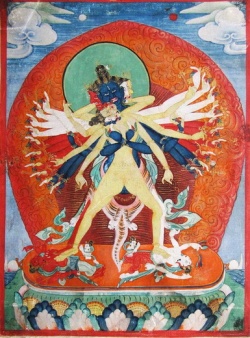Difference between revisions of "The Twenty-Five Kalki (Tib. Rigden)"
(Created page with "01agaaaa.jpg The Twenty-Five Kalki; (Tib. Rigden); The most recent 25 of the 32 Kings of (Wheel of Time) teachings of Buddha Shakyamuni, passed down ...") |
|||
| (One intermediate revision by the same user not shown) | |||
| Line 1: | Line 1: | ||
| − | 01agaaaa.jpg | + | [[File:01agaaaa.jpg|thumb|250px|]] |
The [[Twenty-Five Kalki]]; (Tib. [[Rigden]]); The most recent 25 of the 32 [[Kings]] of ([[Wheel of Time]]) [[teachings of Buddha]] [[Shakyamuni]], passed down from the original seven [[Dharmarajas]] of [[Shambhala]]. | The [[Twenty-Five Kalki]]; (Tib. [[Rigden]]); The most recent 25 of the 32 [[Kings]] of ([[Wheel of Time]]) [[teachings of Buddha]] [[Shakyamuni]], passed down from the original seven [[Dharmarajas]] of [[Shambhala]]. | ||
The [[Kalki]] have often been erroneously termed "[[Kulika]]" by [[Tibetan Buddhist]] [[scholars]] unfamiliar with the original [[Sanskrit]] texts, as [[Buddhist scholar]] John R. Newman explains: | The [[Kalki]] have often been erroneously termed "[[Kulika]]" by [[Tibetan Buddhist]] [[scholars]] unfamiliar with the original [[Sanskrit]] texts, as [[Buddhist scholar]] John R. Newman explains: | ||
| − | .. . so far no one seems to have examined the [[Sanskrit]] [[Kalachakra]] texts. The [[Buddhist]] [[myth]] of the [[Kalkis]] of [[Shambhala]] derives from the [[Hindu]] [[Kalki]] of [[Shambhala]] [[myths]] contained in the [[Mahabharata]] and the {{Wiki|Puranas}}. The [[Vimalaprabha]] even refers to the [[Kalkipuranam]], probably the latest of the upapuranas. This relationship has been obscured by {{Wiki|western}} [[scholars]] who have reconstructed the [[Tibetan]] translation term [[rigs ldan]] as "[[Kulika]]." Although [[Tibetan]] [[rigs ldan]] is used to translate the [[ | + | .. . so far no one seems to have examined the [[Sanskrit]] [[Kalachakra]] texts. The [[Buddhist]] [[myth]] of the [[Kalkis]] of [[Shambhala]] derives from the [[Hindu]] [[Kalki]] of [[Shambhala]] [[myths]] contained in the [[Mahabharata]] and the {{Wiki|Puranas}}. The [[Vimalaprabha]] even refers to the [[Kalkipuranam]], probably the latest of the upapuranas. This relationship has been obscured by {{Wiki|western}} [[scholars]] who have reconstructed the [[Tibetan]] translation term [[rigs ldan]] as "[[Kulika]]." Although [[Tibetan]] [[rigs ldan]] is used to translate the [[Sanskrit]] [[kulika]] in other contexts, here it always represents [[Sanskrit]] [[kalkin]] ([[possessive of kalkah]]; I have used the nomininative [[kalki]]). |
| + | {{R}} | ||
| + | [http://www.fatti-su.it/kings_of_shambhala www.fatti-su.it] | ||
| + | [[Category:Kings of Shambhala]] | ||
Latest revision as of 09:51, 5 April 2014
The Twenty-Five Kalki; (Tib. Rigden); The most recent 25 of the 32 Kings of (Wheel of Time) teachings of Buddha Shakyamuni, passed down from the original seven Dharmarajas of Shambhala.
The Kalki have often been erroneously termed "Kulika" by Tibetan Buddhist scholars unfamiliar with the original Sanskrit texts, as Buddhist scholar John R. Newman explains:
.. . so far no one seems to have examined the Sanskrit Kalachakra texts. The Buddhist myth of the Kalkis of Shambhala derives from the Hindu Kalki of Shambhala myths contained in the Mahabharata and the Puranas. The Vimalaprabha even refers to the Kalkipuranam, probably the latest of the upapuranas. This relationship has been obscured by western scholars who have reconstructed the Tibetan translation term rigs ldan as "Kulika." Although Tibetan rigs ldan is used to translate the Sanskrit kulika in other contexts, here it always represents Sanskrit kalkin (possessive of kalkah; I have used the nomininative kalki).
